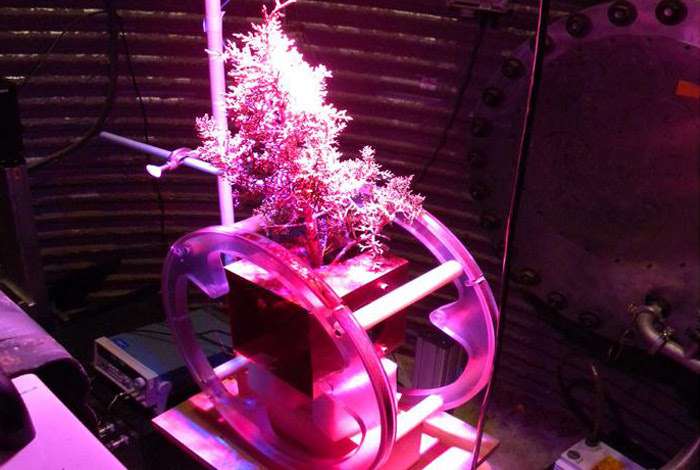Water use by trees is a key part of the hydrological process linking soil to climate and local weather

Los Alamos Lab researchers have made the first simultaneous measurements of Ultra-Low-Field Nuclear Magnetic Resonance (ULF-NMR) and neutron imaging to visualize the movement of water in trees. Water use by trees is a key part of the hydrological process linking soil to climate and local weather. Despite decades of research and method development, non-destructive, in vivo measurements of water uptake and flow in trees are unavailable for field-based measurement. The lack of measurements limits progress towards understanding this important climate factor.
Climate change is predicted to lead to more frequent and severe droughts in many parts of the world. Agriculture, forestry, and meteorology need inexpensive, non-invasive, and simple methods for use in field conditions in order to detect plant water status. Developing an affordable method is a step forward in measurement accuracy, enabling progress in our understanding of vegetation responses and interactions with the environment.
Measurement challenges arise from the opacity of wood and the intricate nature of the water transport system; opposing pressure gradients in adjacent tissues cause water uptake from the soil and delivery of carbohydrates produced in the leaves. Previous approaches to detect water movement in plants have been based on systems using large magnetic fields to obtain NMR signals with good signal-to-noise. Those NMR systems work in regulated temperatures, requiring a cooled magnet and maintaining the system at constant temperature. The physiological configuration and the size and cost of the magnet limit this approach.
The Los Alamos researchers have taken a different approach – keeping the magnetic field low to produce a very light and inexpensive system, suitable for bulk water measurements on trees. The result is an ULF-NMR system that is suitable for use in ambient, outdoor environments to monitor long-term changes in the water contents of living trees non-destructively. The method could easily be duplicated to measure many trees or multiple parts of the same tree. Eliminating the need to cool the ULF-NMR system makes it simpler and reduces measurement costs. The journal Review of Scientific Instruments reported the novel system.
The Laboratory scientists aimed to move the ULF-NMR system toward field application by calibrating the NMR signal for water uptake in different tissues. Therefore, the team conducted simultaneous neutron radiography and ULF-NMR measurements of "heavy water" (deuterated water, D2O) uptake by living branches at the Los Alamos Neutron Science Center (LANSCE).
This measurement of NMR during active neutron imaging was the first of its kind. The success of these measurements proves the concept of non-destructive water flow detection with ULF-NMR and the utility of simultaneous NMR and neutron imaging measurements for calibration. This new capability could enable enhanced visualization of water and carbohydrate transport processes in trees.
The team used the 60-meter Lujan Center Flight Path 5 neutron beam line at LANSCE for the simultaneous measurements of water uptake in living branches. Both ULF-NMR and neutron imaging enable differentiation between the two hydrogen isotopes of water. Alternate watering of branches with these two water sources enabled the researchers to measure the flow rates with both systems simultaneously and compare them. The team also added a surfactant to the source water to change its surface tension and induce bubble formation (cavitation) in the branch's water conductive tissue. Cavitation induced failure of the conductive tissue to simulate drought conditions in nature.The team found that approximately 70 percent of the ULF-NMR signal is due to water moving rapidly towards the leaves in the water-conductive tissue. The remaining approximately 30 percent of the ULF-NMR signal results from slowly moving or bound water within cells and/or tissues related to carbohydrate transport and storage.
More information: "Low-field nuclear magnetic resonance for the in vivo study of water content in trees." Rev. Sci. Instrum. 85, 095110 (2014); dx.doi.org/10.1063/1.4895648
Journal information: Review of Scientific Instruments
Provided by Los Alamos National Laboratory




















